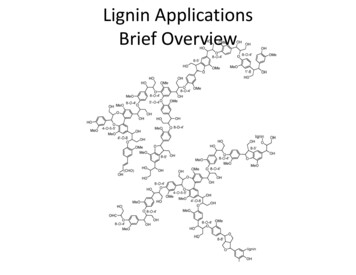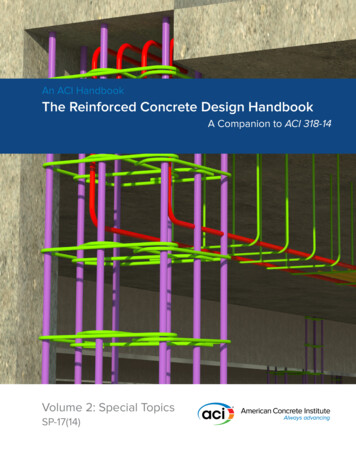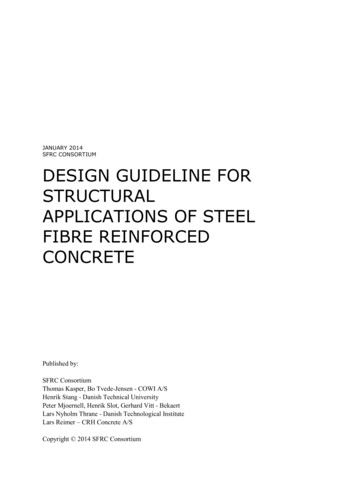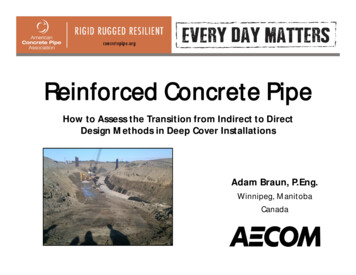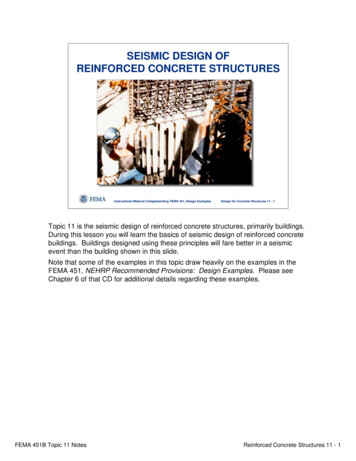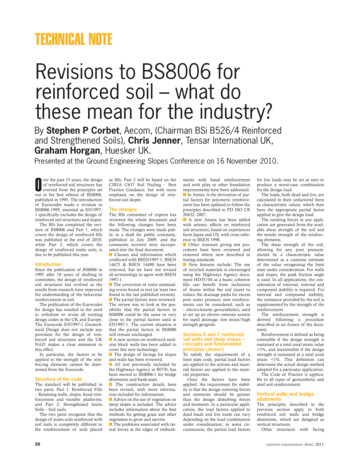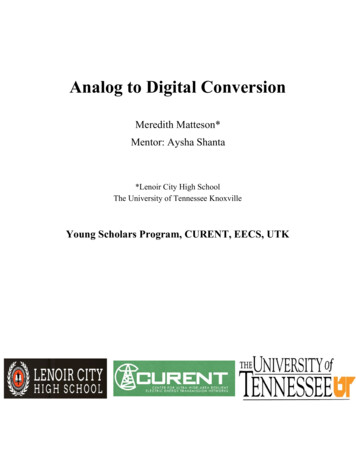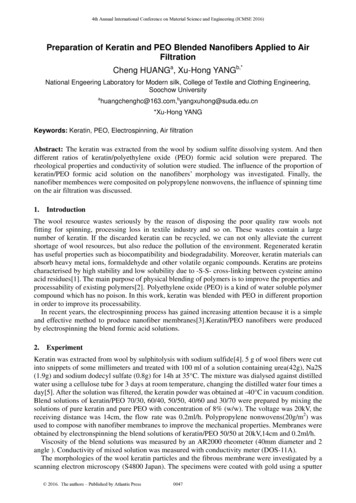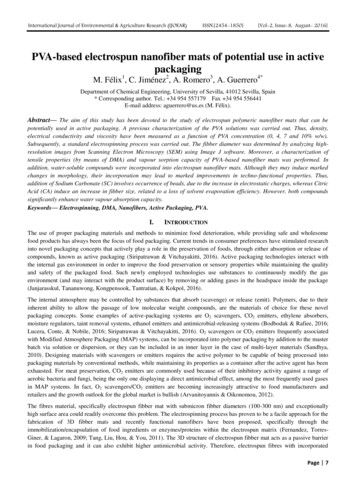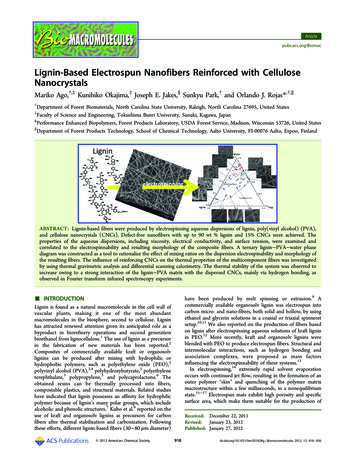
Transcription
Articlepubs.acs.org/BiomacLignin-Based Electrospun Nanofibers Reinforced with CelluloseNanocrystalsMariko Ago,†,‡ Kunihiko Okajima,‡ Joseph E. Jakes,§ Sunkyu Park,† and Orlando J. Rojas*,†, †Department of Forest Biomaterials, North Carolina State University, Raleigh, North Carolina 27695, United StatesFaculty of Science and Engineering, Tokushima Bunri University, Sanuki, Kagawa, Japan§Performance Enhanced Biopolymers, Forest Products Laboratory, USDA Forest Service, Madison, Wisconsin 53726, United States Department of Forest Products Technology, School of Chemical Technology, Aalto University, FI-00076 Aalto, Espoo, Finland‡ABSTRACT: Lignin-based fibers were produced by electrospinning aqueous dispersions of lignin, poly(vinyl alcohol) (PVA),and cellulose nanocrystals (CNCs). Defect-free nanofibers with up to 90 wt % lignin and 15% CNCs were achieved. Theproperties of the aqueous dispersions, including viscosity, electrical conductivity, and surface tension, were examined andcorrelated to the electrospinnability and resulting morphology of the composite fibers. A ternary lignin PVA water phasediagram was constructed as a tool to rationalize the effect of mixing ratios on the dispersion electrospinability and morphology ofthe resulting fibers. The influence of reinforcing CNCs on the thermal properties of the multicomponent fibers was investigatedby using thermal gravimetric analysis and differential scanning calorimetry. The thermal stability of the system was observed toincrease owing to a strong interaction of the lignin PVA matrix with the dispersed CNCs, mainly via hydrogen bonding, asobserved in Fourier transform infrared spectroscopy experiments. have been produced by melt spinning or extrusion.9 Acommercially available organosolv lignin was electrospun intocarbon micro- and nano-fibers, both solid and hollow, by usingethanol and glycerin solutions in a coaxial or triaxial spinneretsetup.10,11 We also reported on the production of fibers basedon lignin after electrospinning aqueous solutions of kraft ligninin PEO.12 More recently, kraft and organosolv lignins wereblended with PEO to produce electrospun fibers. Structural andintermolecular interactions, such as hydrogen bonding andassociation complexes, were proposed as main factorsinfluencing the electrospinnability of these systems.13In electrospinning,14 extremely rapid solvent evaporationoccurs with continued jet flow, resulting in the formation of anouter polymer “skin” and quenching of the polymer matrixmacrostructure within a few milliseconds, in a nonequilibriumstate.15 17 Electrospun mats exhibit high porosity and specificsurface area, which make them suitable for the production ofINTRODUCTIONLignin is found as a natural macromolecule in the cell wall ofvascular plants, making it one of the most abundantmacromolecules in the biosphere, second to cellulose. Ligninhas attracted renewed attention given its anticipated role as abyproduct in biorefinery operations and second generationbioethanol from lignocellulose.1 The use of lignin as a precursorin the fabrication of new materials has been reported.2Composites of commercially available kraft or organosolvlignins can be produced after mixing with hydrophilic orhydrophobic polymers, such as polyethylene oxide (PEO),3polyvinyl alcohol (PVA),3,4 polyhydroxybutyrate,5 polyethyleneterephthalate,3 polypropylene,3 and polycaprolactone.6 Theobtained resins can be thermally processed into fibers,compostable plastics, and structural materials. Related studieshave indicated that lignin possesses an affinity for hydrophilicpolymer because of lignin’s many polar groups, which includealcoholic and phenolic structures.7 Kubo et al.8 reported on theuse of kraft and organosolv lignins as precursors for carbonfibers after thermal stabilization and carbonization. Followingthese efforts, different lignin-based fibers (30 80 μm diameter) 2012 American Chemical SocietyReceived: December 22, 2011Revised: January 23, 2012Published: January 27, 2012918dx.doi.org/10.1021/bm201828g Biomacromolecules 2012, 13, 918 926
BiomacromoleculesArticlewater with 12000 MWCO membrane was performed to remove traceamounts of residual sulfuric acid from the suspension.The dimensions of the obtained CNCs (Figure 1) were typically100 150 nm in length and 10 20 nm in width, in agreement withvalues reported in the literature.31,32 The obtained CNC suspensionwas sonicated for 15 min to avoid aggregation of CNCs and keptrefrigerated at 4 C until use. The concentration of CNCs in thesuspension was determined gravimetrically.Multicomponent Electrospun Fibers and Solid Films. PVAaqueous solutions with concentrations ranging from 1.25 to 20 wt %were prepared and given amounts of lignin were added. In addition,aqueous dispersions containing CNC were prepared by using therespective mass ratios of lignin, PVA and CNC. The solutions orsuspensions were kept under vigorous mechanical agitation at 60 Cfor 15 min, followed by cooling to room temperature under stirring for120 min. Any given batch of these systems was used to produceelectrospun fibers or thin films after no more than 1 week storage time.The suspensions were loaded into a 10-ml plastic, disposablesyringe with a 22 gauge needle. The needle was connected to thepositive terminal of a voltage generator, which generated positivevoltages up to 50 kV DC (Glassman High Voltage, Series EL). Anoperating voltage of 19 kV and a flow rate of 8 μL/min (by acomputer-controlled syringe pump) were used in typical electrospinning experiments. An aluminum plate of 15 cm diameter coveredwith a thin aluminum foil and connected to the negative electrode ofthe power supply (ground) was used as a collector. The workingdistance was adjusted to 22 cm. Electrospinning was performed atroom temperature and at a relative humidity between 35 and 45%. Thecollected electrospun mats were kept in a desiccator containinganhydrous CaSO4. Solvent-casting was applied in the production ofmulticomponent solid films. To this end, the solutions or suspensionswere poured onto a clean Teflon plate, kept in a dust-free atmosphere,and allowed to dry overnight at room temperature.Conductivity, Surface Tension, and Viscosity. Conductivityand surface tension of the respective solutions or suspensions weremeasured at room temperature using a conductivity meter (CornigInc., model 441) and an electrobalance (CAHN, DCA-312),respectively. The viscosity was determined at 25 C by a programmable rheometer (TA Instruments, AR2000), as a function of shearrate over a range of 0.1 1000 s 1 in a parallel plate configuration (40mm diameter geometry).Fiber Characterization. The morphology of the nanofibers in theelectrospun mats was examined using a field emission scanningelectron microscope (FE-SEM, JEOL, 6400F) operating at 5 kV and aworking distance 20 mm. A small piece of the nanofiber mat was fixedon carbon tape and then sputtered with Au/Pd. The diameterdistribution was obtained from 40 fibers that were selected randomlyand image-analyzed (Revolution software).Fourier transform infrared spectroscopy (FT-IR) was used toinvestigate the basic chemical characteristics of the electrospun mats. ANicolet FT-IR spectrometer (Thermo Scientific) was used in thetransmittance mode. The multicomponent electrospun mats weredried overnight at 40 C under vacuum and then grounded with KBr.During any intermediate preparation procedure the samples weremaintained in desiccators containing anhydrous CaSO4 to maintain amoisture-free environment. All spectra were collected with a 4 cm 1wavenumber resolution after 64 continuous scans.Thermogravimetric analyses were performed using TGA (Q500TGA, TA Instruments) with 10 mg of sample mounted in a platinumpan and heated from 30 to 600 C at a rate of 10 C/min under a N2atmosphere. Additional thermal properties were determined with adifferential scanning calorimeter (DSC Q100, TA Instruments) byfollowing two different procedures. In the first set of experiments, 5mg of the “as produced” fiber mats was placed in the DSC cell andheated from 50 to 250 C using a 10 C min 1 heating rate. In theother experiments, the fiber mats were heated up to 160 C andmaintained at this temperature for 5 min, followed by cooling down to0 C (10 C/min cooling rate), then heated again to 240 C (10 C/min heating rate). The melting temperature (Tm) was taken as thepeak temperature of the endotherms in thermograms from bothhigh performance materials such as filters, sensors, medicalmaterials, flexible coating, and so on.18 22 Recently, cellulosenanocrystals (CNCs) 23 25 have made inroads in theproduction of new materials as reinforcing solid phase inelectrospun fibers.26 30 The high specific surface of CNCs andthe available hydroxyl groups suggest the possibility to exploithydrogen bonding in host matrices to further these initialefforts to produce new materials.This work describes the manufacture of lignin-based fibermats produced by electrospinning aqueous dispersions oflignin, PVA, and CNCs. The resulting composite fibersdisplayed unique and tailorable morphologies and properties.Additionally, they can be considered as a simple model toinvestigate the nature of intermolecular interactions and theirrole in structure property relationships, which could betranslated to the more complex natural fibers. PVA was usedas an adhesive for cellulose and lignin, the latter of which is aprincipal component of the fiber matrix. The morphology ofthe resulting fibers was analyzed via scanning electronmicroscopy (SEM) and the enhancement of the thermalstability of the electrospun mats by incorporation of CNCs wasdemonstrated by thermal gravimetric analysis (TGA) anddifferential scanning calorimetry (DSC). MATERIALS AND METHODSLignin (kraft lignin from softwood) was obtained from Sigma-Aldrich(St. Louis, MO) with reported molecular weight of 10 kDa (alkalilignin, low sulfur, CAS number 8068-05-1). Poly(vinyl alcohol)(PVA), also from same supplier under trade name Mowiol 20-98(CAS Number: 9002-89-5), was reported to have a molecular weightof 125 kDa and degree of hydrolysis of 98% (2% acetyl groups). Thelignin and PVA were used to prepare aqueous solutions forelectrospinning without further purification.Figure 1. AFM height image of cellulose nanocrystals prepared fromcotton fibers by acid hydrolysis. The CNCs were spin coated onto asilicon wafer primed with a layer of polyethyleneimine.Cellulose nanocrystals (CNCs) were prepared by acid hydrolysisfrom pure cotton (Figure 1). Briefly, cotton was first acid hydrolyzedwith 65 wt % sulfuric acid at 50 C for 20 min. The resultingdispersion was poured into 500 g of ice cubes and washed withdistilled water until neutral pH by successive centrifugation at 12000rpm (10 C, 20 min). Finally, dialysis for 1 week against deionized919dx.doi.org/10.1021/bm201828g Biomacromolecules 2012, 13, 918 926
BiomacromoleculesArticleFigure 2. Representative FE-SEM micrographs of lignin-based fibers upon electrospinning aqueous solutions containing PVA at concentrations of 10(upper row, (a) series) and 5% (bottom row, (b) series). The different lignin PVA mass ratios of the obtained, solid fibers are indicated as follows:0:100 (1); 20:80 (2); 50:50 (3); and 75:25 (4). The SEM scale bar corresponds to 5 μm.experimental procedures. The degree of relative crystallinity (Xc) wasestimated from the endothermic area using eq 1:Xc(%) ΔH /ΔH 0 100Figure 2a-1 4 and Figure 3), with average values ranging from61 3 to 509 34 nm.(1)where ΔH is the measured enthalpy of fusion from DSC thermogramsand ΔH0 is the reference enthalpy of fusion for 100% crystalline PVA(ΔH0 158 J g 1), as reported in the literature.33 All the samples usedin DSC measurements were dried overnight at 40 C under vacuum. RESULTS AND DISCUSSIONBicomponent Electrospun Fibers. Fiber mats based onlignin and PVA were obtained after electrospinning aqueousdispersions of given compositions. The concentration of ligninin the precursor aqueous solution was varied to obtain fiberswith lignin content from 5 to 90 wt % based on solids. Purelignin solutions did not produce fibers after electrospinning.Figure 2 shows typical SEM images of the electrospun fibermats (PVA and lignin PVA) obtained from the aqueoussolutions of 10 (Figure 2a series) and 5% (Figure 2b series)PVA concentration. The lignin-free, PVA solution at 10%concentration was readily electrospun and yielded bead-freefibers (Figure 2a-1). Likewise, bead-free and uniform fiberswere obtained upon the addition of lignin to this solution(Figure 2a-2 4). Lignin PVA mixtures of 80:20 mass ratio orhigher, were difficult to electrospin due to the onset of phaseseparation and the significantly high viscosity of the system. Incontrast to the case of 10% PVA precursor solution, somebeading takes place upon electrospinning lignin-free, 5% PVAsolutions (Figure 2b-1). Interestingly, the addition of lignin tothese solutions enhances fiber formation (Figure 2b-2 4): atransition from beading to fiber formation occurred as thelignin concentration increased, eventually resulting in bead-freefibers for lignin-PVA mass ratio of 75:25. The enhancedelectrospinnability and fiber morphology as lignin is incorporated to the PVA solution is hypothesized to originate by theeffect of molecular interactions in the precursor aqueoussolution, as will be discussed in other sections of this paper.In the case of 10% PVA precursor solutions, it is observedthat the radius of the fibers increased with lignin addition (seeFigure 3. Average radius of fibers obtained after electrospinningprecursor 10 wt % PVA aqueous solutions before and after loading itwith lignin (% lignin in the solid fiber is indicated in the plot; seeFigure 2a-1 4). The standard deviations were in most cases smallerthan the size of the symbols used. Lines are added as guides to the eye.The electrospinning process fundamentally requires thetransfer of electric charges from the electrode to the spinningfluid at the terminus of the tip. Solutions of low electricalconductivity are subject to insufficient elongation by electricalforces on the fluid jet which is otherwise a condition requiredto produce uniform fibers.34 36 In addition, the density of beadfree fibers can be improved by lowering the surface tension ofthe solution.34 36 Therefore, we report the electrical conductivity and surface tension (Table 1) as well as the viscosity(Figure 4) of the systems that were more difficult toelectrospin, including solutions consisting of 5 or 7 wt %PVA (with and without lignin added).920dx.doi.org/10.1021/bm201828g Biomacromolecules 2012, 13, 918 926
BiomacromoleculesArticleTable 1. Electrical Conductivity and Surface Tension of Solutions Based on 5 or 7% PVA Concentration (To Produce Fiberswith Lignin Contents of 0 90 wt % Based on Solids)afiber (solid) compositionlignin PVA:% CNCPVA precursor aqueoussolution, wt %polymer concentration,wt .8411.932.172.072.052.03surface tension,mN/m63.147.543.241.640.6 0.40.60.30.50.1 3.043.6morphologybeadsbeads fibersbeads fibersbead-free fibersbead-free fibersno jetbead-free fibersbeads fibersbeads fibersbead-free fibersbeads fibersbeads fibersbeads fibersbeads fibersaData for lignin PVA CNC dispersions are also included. The composition of the solution is expressed as lignin:PVA mass ratios and % CNC ontotal solids (lignin:PVA/%CNC), and the morphology of the electrospun systems are indicated. bCannot be measured due to the high viscosity.A ternary phase diagram was constructed after performingelectrospinning with a number of lignin PVA dispersions, asindicated (Figure 5). This ternary diagram helps to betterFigure 4. Mean apparent viscosity of 5 wt % PVA solutions withdifferent lignin loads (expressed as % lignin in the solid fibers). Theviscosity was calculated from the ratio of shear stress and shear rate inthe range of 140 550 s 1.The electrical conductivity of the lignin-PVA solutionssignificantly increased and their surface tension decreasedwith lignin concentration. Beading upon electrospinning wasidentified to occur at conductivities lower and surface tensionshigher than the respective critical values ( 5.24 mS/cm and 43.2 mN/m, respectively; see Table 1 and also Figure 2b-1,2).The viscosity of lignin PVA solutions increased with theaddition of lignin. At about 75% lignin, a steep increase inviscosity with lignin loading is clearly noted (Figure 4). At thisconcentration, the morphology of the electrospun systemchanges from beaded fibers to bead-free fibers, as discussedpreviously. This behavior at the threshold concentration can beexplained by the enhanced interaction between PVA and ligninmolecules. Overall, it is concluded that lignin PVA systems canbe tuned to facilitate electrospinnability by a properformulation of the dispersion and, thus, solution properties(mainly electrical conductivity, surface tension, and viscosity).Figure 5. Ternary diagram indicating electrospinnability domainsaccording to the composition of the precursor solutions (massfractions of lignin, PVA, and water). The respective morphology afterelectrospinning is represented by half-filled circles to indicate beading,filled circles for bead-free fibers, and unfilled circles for a phaseseparation zone (not suitable for electrospinning). Lines are added asguides to the eye to identify the interfaces between the differentdomains and iso-radius contour lines are also included according toSEM images of electrospunfibers (representative SEM images areadded around the ternary diagram and they include size bars of 5 μm).identify and predict electrospinnability domains. The relationbetween solution composition (expressed as mass fractions inthe precursor dispersion) and resultant fiber morphologies canbe elucidated. Varying composition along a vertical line in theternary diagram indicates changes in solvent (water) content,which increases as the composition moves closer to the “water”921dx.doi.org/10.1021/bm201828g Biomacromolecules 2012, 13, 918 926
BiomacromoleculesArticleFigure 6. Changes in apparent viscosity as a function of the shear rate for lignin PVA solutions and lignin PVA CNC dispersions: 75:25/%CNC(a) and 20:80/%CNC (b). The CNC loading (%CNC) is varied between 0 and 15%, as indicated in the respective plot.Figure 7. SEM images of nanofibers obtained by electrospining lignin PVA systems (75:25 and 20:80, upper (a) and lower (b) series, respectively)with different CNC loadings (% CNC in lignin PVA CNC). Included are reference CNC-free systems (lignin PVA/0% CNC), 75:25/0 (a-1), or20:80/0 (b-1), and fibers with 5% CNC loading (lignin PVA/5%CNC; a-2 or b-2), 10% CNC loading (lignin PVA/10%CNC; a-3 or b-3), and15% CNC loading (lignin PVA/15% CNC; a-4 or b-4).Multicomponent Electrospun Fibers. CNCs were usedto produce multicomponent (lignin PVA CNC) nanofibersof different compositions. The concentrations of lignin andPVA are given as relative mass fraction in the respective fiberand the % of CNC is given based on total solids. Thecomposition is thereafter represented by “lignin/PVA/%CNC”to indicate the mass ratio between lignin and PVA and the %CNC based on total solids. Lignin PVA CNC fiber precursor dispersions are discussed in more detail in thefollowing sections, but for brevity, only two of the manylignin PVA compositions tested are described as far as fiberformation, specifically, we focus on dispersions with mass ratiosof the matrix system (lignin PVA) of 75:25 and 20:80 (and 5,10, and 15% CNC loading based on total solids).We examine the role of the interactions between thedispersed CNCs and the lignin PVA medium by measuringthe apparent viscosity of the dispersions as a function of theshear rate γ (Figure 6). The results indicate a non-Newtonianbehavior that is well described by a power law relationshipbetween shear stress (τ) and shear rates (γ),37 τ kγc, yielding aapex. The changes in the horizontal direction indicate the givenlignin:PVA mass ratios.Three distinctive composition domains were determined,corresponding to (1) beaded fibers, (2) bead-free fibers, and(3) macroscale phase separation. In the latter case, solutions ofvery high viscosity were obtained and electrospinning failed.Bead-free fibers were observed within a range of componentconcentrations in precursor solutions between 0 and 32%(lignin), 2 and 19% (PVA), and 66 and 86% (water),respectively. It was found that the diameter of the electrospunfibers increased with the total polymer concentration. Highlignin loading was required to produce bead-free fibers. This isan interesting observation because usually PVA is regarded as agood fiber-forming polymer while lignin is not; yet, thesynergistic effect when the two components are mixed isapparent (see also Figure 2). Contour lines corresponding toiso-radius were drawn. To the best of our knowledge, such aternary diagram is reported here for the first time to identifyelectrospinnability domains.922dx.doi.org/10.1021/bm201828g Biomacromolecules 2012, 13, 918 926
BiomacromoleculesArticleFigure 8. Scanning electron microscopy of the cross-section of solid thin films produced from lignin PVA CNC systems prepared by evaporationcasting. The specimens were prepared by a freeze fracturing method using liquid nitrogen. Shown are the films with three CNC loadings, that is,lignin PVA/%CNC of 75:25/0% (a), 75:25/5% (b), and 75:25/15% (c).power-law index c between 0.26 to 0.89 (shear thinning) and aconsistency coefficient k from 0.15 to 20.The viscosity of the precursor suspensions (lignin PVA)increased with addition of CNC, which was more evident in thecase of 75:25/%CNC systems. There are abundant experimental and theoretical studies which have shown that theviscosity of dispersions of polymers filled with nanoparticlesincreases with the content of the dispersed phase (and alsobecomes more shear-thinning).38 42 In fact, when sheared atlow shear rates these systems are highly viscous and gel-like dueto the network that is formed. This observation highlights thestrong interaction that exists between CNCs and lignin, whichis the principal component in 75:25 (lignin PVA) systems. Asignificant shear-thinning behavior is observed and explained bythe fluctuating structure of the dispersion which is disruptedunder shear which produces CNC alignment along the flowdirection. In fact, the viscous 75:25/%CNC lignin PVA CNCsuspensions becomes less viscous under increased shear rates;interestingly, the viscosity of the dispersions decreasedasymptotically until reaching values close to the correspondingbase, CNC-free lignin PVA solutions at 1000 s 1.The morphology of the multicomponent fibers producedfrom 75:25/CNC systems was significantly influenced by thepresence of CNCs (see Figure 7a series for 0, 5, 10, or 15%CNC based on total solids). Fibers with a typical radius of 73 5 and 114 4 nm were obtained at the lowest and highestCNC concentrations tested, 5 and 15% CNC, respectively.More specifically, an increase in fiber radius is observed withthe addition of CNC. In addition, a few beads were observed atthe lower CNC loadings. The shapes of the beads changedfrom spherical to spindle-like as the concentration wasincreased from 5 to 10%. Furthermore, considering Figure 6aand Figure 7a series, it can be inferred that more uniformmulticomponent fibers are produced with highly shear-thinningdispersions.In 75:25/%CNC systems the interaction between the CNCsand lignin is expected to dominate. Both the surface tension(Table 1) and viscosity (Figure 6a) are observed to increasewith CNC loading. The increase in surface tension of thesuspension favors beading while the increase in viscosity favorsbead-free fibers.35 It is apparent that, for dispersions with 15%CNCs, viscous effects are dominant.In the systems with PVA as the principal component (20:80/%CNC systems), beaded fibers were obtained in all 20:80/%CNC systems (Figure 7b series). Noticeably, upon the additionof CNCs the surface tension decreases (Table 1) and theviscosity increases (Figure 6b); however, compared to 75:25systems, these changes are more limited and do notsubstantially influence the resulting fiber morphologies. Overall,the observed changes in the multicomponent nanofibers uponaddition of CNCs depend on a complex balance of effectsbrought about by the dispersed nanoparticles. Importantly, theviscosity and observed morphology results support thehypothesis that a strong interaction exists between CNCs andthe lignin phase.Electrospining is an extremely rapid process where solventevaporation occurs with continuous jet flow, resulting in theformation of an outer polymer layer and the quenching of thepolymer matrix structure.15 17,43 Nevertheless, further insightinto the effect of CNCs on the molecular interactions betweenlignin and PVA can be gained from solid thin films prepared bythe evaporation-casting method. In this process, the characteristic times are much higher due to the slow rates of solventevaporation, leading to final conditions that are closer toequilibrium. Figure 8 includes SEM images for such films wherelarge phase-separated domains (with characteristic sizes of theorder of 500 1000 nm) can be observed for CNC-free systems(Figure 8a). When CNCs are loaded in the system, thecharacteristic domain size is reduced or suppressed (Figure8b,c). In general, phase separation occurs during evaporation ofhighly concentrated polymer solutions.44 The phase-separatedpolymer usually evolves into domains with spherical shapes dueto the effect of interfacial tension. However, phase separation isprevented if the molecular mobility of the dispersed polymer ismuch lower than the evaporation rate of the solvent. This effectis hypothesized to occur in the present systems after addition ofCNCs: the molecular mobility of the lignin PVA matrix isdecreased with the addition of CNCs, and therefore, phaseseparation is reduced.We now turn our attention to the chemical characterizationof electrospun mats produced from the multicomponentsystems discussed so far. FT-IR spectra of lignin-based fibersas well as solid film prepared from a CNC suspension wererecorded under transmittance mode (Figure 9). As a reference,a pure CNC solid film was prepared by evaporation-castingfrom 5 wt % CNC aqueous suspension. Characteristicabsorbance peaks of lignin at 1598, 1267, 1219, 1130, and1037 cm 1 were assigned respectively to the aromatic skeletalvibration, C O of guaiacyl ring, C C and C O stretch,aromatic C H in plane deformation in guaiacyl ring, andaromatic C H in plane deformation.45 Typical absorbancies forcellulose were assigned to wavenumbers of 1316, 1161, and923dx.doi.org/10.1021/bm201828g Biomacromolecules 2012, 13, 918 926
BiomacromoleculesArticleFigure 9. FT-IR spectra for electrospun lignin PVA CNC mats withdifferent CNC content: lignin PVA/%CNC of 75:25/0% (a), 75:25/5% (b), 75:25/10% (c), and 75:25/15% (d). A reference filmconsisting of pure CNC is also included (e).1059 cm 1 for the CH2 vibration, C O C asymmetric valencevibration, and C O valence vibration, respectively. These peakscorrelated with the CNC content in the respective system.Most importantly to the present discussion is the observationthat compared to CNC-free matrices, fibers with increasedamounts of CNCs yielded a shift of the main OH peak regionof about 3400 cm 1 to lower wavenumbers. This can beexplained by the strong hydrogen bonding interactions betweenthe hydrophilic CNC particles and the lignin and PVA medium.Further support for this hypothesis is provided by the shape ofthe broad absorbance peak between 3550 and 3200 cm 1,which is characteristic of OH stretching from the inter- andintramolecular hydrogen bonds.9,46 The shape of this band issubstantially different for samples with or without CNCpresent. Kraft lignin is a polyphenolic compound containingsubstituted aromatic groups with different functions rangingfrom hydroxyl (phenolic or alkyl), conjugated double bond, andmethoxyl groups.47 Therefore, it is expected that some of thesefunctional groups can participate in hydrogen bonding with thehydroxyl groups on the surface of CNCs.Sulfate groups were grafted onto the surface of CNCs duringacid sulfuric acid-catalyzed hydrolysis. The amount of suchgroups estimated from elemental analysis was about 0.7%,which according to the surface area of the CNC nanoparticles,corresponds to a surface charge density of about 0.30 e/nm2.48Thus, the surface density of sulfate groups on the CNCs isrelatively small compared to the total available hydroxyl groups.Therefore it is reasonable to expect that the interactionsbetween dispersed CNCs and the lignin/PVA matrices aremainly ascribed to the contribution of hydroxyl groups inhydrogen bonding.Figure 10 shows thermogravimetric profiles and theirderivatives for multicomponent electrospun mats of differentCNC content (the curves for pure CNC are included as areference in the inset of Figure 10). For the weight lossderivative, a sharp and a broad degradation peak are observedfor CNC-free mats (lignin PVA ratio of 75:25, Figure 10d)centered at around 233 and 308 C, respectively. These peakscorrespond to the thermal decomposition of PVA and lignin,respectively. The melting point of pure PVA is 220 C and thefirst degradation signal corresponds to chain-stripping reactionproduced by the removal of water molecules (dehydration ofPVA polymers).49,50 Lignin decomposition is observed over abroad temperature range and a residue at 500 C equivalent toFigure 10. Thermogravimetric curves and derivatives of lignin PVA CNC electrospun mats with different CNC content. Indicated ar
mable rheometer (TA Instruments, AR2000), as a function of shear rate over a range of 0.1 1000 s 1 in a parallel plate configuration (40 mm diameter geometry). Fiber Characterization. The morphology of the nanofibers in the electrospun mats was examined using a field emission scanning electron microscope (FE-SEM, JEOL, 6400F) operating at 5 .
